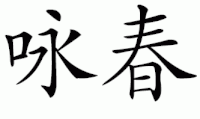Wing Chun Kuen
 |
|
| Also known as | Wing Tsun, Ving Tsun |
|---|---|
| Focus | Striking, Trapping |
| Country of origin |
|
| Creator | Ng Mui of the Five Elders |
| Parenthood | Fujian White Crane, Shequan |
| Descendant arts | Jeet Kune Do and Human Martial Art (HMA) |
| Olympic sport | No |
| Wing Chun | |||||||||||||||||||||||||||||||||||
| Traditional Chinese | |||||||||||||||||||||||||||||||||||
|---|---|---|---|---|---|---|---|---|---|---|---|---|---|---|---|---|---|---|---|---|---|---|---|---|---|---|---|---|---|---|---|---|---|---|---|
| Simplified Chinese | |||||||||||||||||||||||||||||||||||
| Hanyu Pinyin | Yǒng Chūn | ||||||||||||||||||||||||||||||||||
| Cantonese Yale | Wihng Cheūn | ||||||||||||||||||||||||||||||||||
| Literal meaning | "Spring Chant" | ||||||||||||||||||||||||||||||||||
|
|||||||||||||||||||||||||||||||||||
Wing Chun (traditional Chinese: 詠春) is a traditional Southern Chinese Kung fu (wushu) specializing in close range combat.
Wing Chun is the most common romanization, from the Cantonese pronunciation (simplified Chinese: 咏春; traditional Chinese: 詠春; Cantonese Yale: Wing6 Cheun1; pinyin: Yǒng Chūn; literally: "Spring Chant"). It is also romanized as Ving Tsun or Wing Tsun, and sometimes the characters are substituted with a homonym (Cantonese Yale: Wing6 Cheun1; literally: "Eternal Spring"). Even though it could be considered a linguistically erroneous romanization at least from English-speaking countries perspective, especially in Finland, Germany and Turkey (and as a commonplace term in some other countries such as Austria, Bulgaria, Italy, Slovakia).
The alternative characters 永春 "eternal spring" are also associated with some other southern Chinese martial arts, including Weng Chun Kung Fu and Yong Chun.
Many Wing Chun lineages emphasize fighting on the outside of the opponent rather than facing them head on (nose to ear rather than nose to nose). Such a position could be described as standing at an angle at least 30 degrees outside of the opponents lead shoulder, where the Wing Chun practitioner can strike with both their arms, while their opponent can only strike with one of their own arms due to poor positioning. This is often referred to as "taking the blindside" or "fighting on the outside gate".
Balance is related to structure because a well-balanced body recovers more quickly from stalled attacks. Wing Chun trains the awareness of one's own body movement derived from muscular, tendon, and articular sources. Performing Wing Chun's forms such as Chum Kiu or the Wooden Dummy form greatly improve proprioception.
...
Wikipedia
